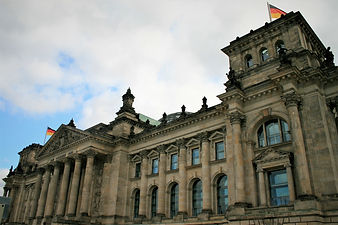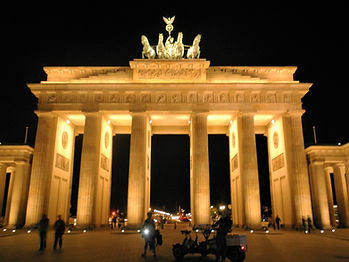
Berlin (Part One), Germany
After eight months of driving around Europe with dodgy brakes, we finally decided that we should get them looked at. The first auto repair shop we came across was joined to a BMW dealership, and we didn't think they would appreciate a big, ugly campervan turning up in their driveway. The next one was a tiny independent business that didn't look promising, but a man came out and assisted us straight away. With only a brief inspection he informed us that the brake fluid wasn't leaking and our brake pads were fine, but the brake fluid needed replacing due to there being water in the lines. His shop was too small for this job, so he verbally directed us elsewhere. A few minutes away we found a whole street of garages, but we had no idea which one we the man had recommended. We picked one at random, spoke to the man in charge and before we knew it our car was propped up on the car lift and three mechanics were working on it. We were truly appreciative of their efficiency, although we were questioning why three mechanics were sitting around doing nothing. Anyway, within half an hour the brake fluid was changed and we were back on the road with much improved stopping power.
We dropped off the van at a campsite then caught a bus into Berlin. Annoyingly, we jumped off the bus a couple of stops too early, requiring us to catch three trains to reach our destination. Once we picked up a map to prevent this sort of thing from happening again, we headed over to the Hamburger Bahnhof, a contemporary art gallery housed in an old train station. Our travel guide told us it was free on Thursday afternoons, but when we arrived we found this was no longer the case. The entrance fee was pretty steep and it wasn't high on our list of must-sees, so we saved our money and left.
Danny, being a Bauhaus fan, wandered through the Bauhaus Museum, which he loved. In the gift shop he bought some sort of fancy “functionalist” pencil, which he also loved. Meanwhile, I, not being a Bauhaus fan, visited the fantastic Berlin Wall Documentation Centre. Most of the site was an outdoor museum, running for about a kilometre within the old No Man's Land (in the middle of the two sides of the Berlin Wall). Parts of the Wall were still standing, and were mostly covered in graffiti. Every 100 metres or so were signs, photos and audio clips, providing little snippets of the history of the wall. There was also a large memorial dedicated to all the people who died trying to cross from East to West. The actual Centre itself didn't contain a whole lot – a video of the Berlin Wall in 1990, more photos and a viewing platform over a preserved section of the Wall and No Man's Land. I spent hours there, absorbing the harrowing details.
While I was on the bus back to the caravan park, I became worried that I had missed my stop because I didn't recognise any of the landmarks we were driving by. So I jumped off and started walking back along the road, hoping the park would magically appear in front of me. After 15 minutes I came across a supermarket that I remembered passing on the way into the city earlier that day, and I realised that I was walking the wrong way. I stopped anyway to ask a couple of locals the way to the campsite, and yes, it was about two to three kilometres away in the first direction I had been travelling on the bus. Frustrated with myself I set off again, only to be stopped five minutes later by a car pulling up beside me. One of the old ladies that I just spoken to at the supermarket rolled down her window and offered me a lift to the campsite. I could have hugged her. I hopped straight in the car, not fearing that she may have been a serial killer, but instead appreciating the wonderful kindness of strangers.
.jpg)
.jpg)
.jpg)
When we checked out of the caravan park the next morning we discovered we had to pay for the exact amount of electricity used – they took readings from the individual meters at each camp site. this was definitely a first for us. We grudgingly forked out the money, then drove halfway to the city and parked just outside the “Environmental Zone”, the central part of the city that only certain registered vehicles can enter. From here we still had to catch three trains to reach the middle of the city. I found it bewildering that Berlin has over 20 train lines and only two go to its most famous sight, the Brandenburg Gate.
The first sight we saw as we exited the station was the iconic Gate, but our eyes were immediately drawn to the giant cherry picker parked in front of it. It wasn't really worth taking photos of it with this obstruction, so we walked over to the Reichstag, the seat of the German parliament. Our plan was to travel up to the glass dome for views over the city, but we were informed that this required an online booking two to three days in advance. It would have been helpful if our guide book had mentioned that. So far, our sightseeing efforts weren't going so great in Berlin.
Next stop was the Holocaust Memorial, which was open, free and didn't require reservations. A massive outdoor space had been covered in thousands of grey square blocks of differing heights, ranging from one to two metres. It had a maze-like feel to it (without the dead ends) and aesthetically it was a stunning sight. Underground was a museum dedicated to victims of the Holocaust, with quotes and family stories sitting on top of light boxes on the floor. No matter how many war memorials we visit, the shock and heartache never diminish.
From the Memorial we headed over to the Sony Centre, a modern building complex full of stores and eateries. Inside we found an Australian cafe, but there didn't seem to be anything Australian about it except the name. the building itself was very cool though, with a large glass roof in a sun-like pattern sending reflections of light all around.
Nearby was Checkpoint Charlie, a former crossing point between East and West Berlin, where the popular tourist attraction is to have your passport stamped with seven different designs used during the East/West split. We got sucked into doing it, reasoning that it made up for all the stamps we missed out on when crossing unmanned borders throughout Europe.

_JPG.jpg)
_JPG.jpg)
After our passports had been uselessly decorated we visited the New National Gallery, consisting mostly of German modern art but with a few big names thrown in here and there. One section was dedicated to art created during WWII, which was probably the most interesting part of the museum. On the whole we enjoyed it, partly because the gallery wasn't mind-numbingly huge, but also because most of the works were of a decent standard.
Back out on the street we found the site of Hitler's former bunker, which was now an apartment block with a plaque. Not really worth the detour.
WiFi didn't seem to be popular in Germany, so I spent part of the afternoon searching for an internet cafe to attempt to register us for the Reichstag. I was hoping it would be easy and I could select a date and time online, but the website required me to send an email then wait for a response. Being a Friday afternoon, I thought my chances of hearing back before we left Berlin would be slim. I sent the email anyway and crossed my fingers.
We walked past the enormous Berliner Dom, which was one of the more impressive cathedrals we had seen, on the way to a bar, but not one we planned on drinking in. This bar broadcasted international sports, including AFL, and I was hoping they would show the Carlton game tomorrow. The manager on duty checked the TV guide, but apparently the Rugby World Cup is more important to ESPN than AFL. Disappointing.
For dinner we found a cheap Vietnamese restaurant - I don't think we had eaten Vietnamese since leaving Vietnam. We ate the most amazing spring rolls, pho and beef noodles, and it made us realise how much we miss Vietnamese food. Definitely better than Chinese food. We promised ourselves that we would look out for it more often. After dinner we walked back along the main street to the Brandenburg Gate to take photos of it lit up at night (minus the cherry picker). Then it was only another three trains back to the car.


_JPG.jpg)



